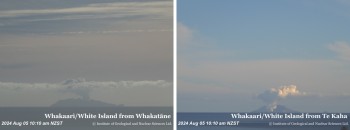
New camera keeping an eye on Whakaari/White Island
Our volcano camera followers will have noticed a new camera we recently installed at Te Kaha, in the Bay of Plenty. This camera looks west, giving another view toward Whakaari/White Island and the 10-minute images can be viewed on our website. You may also have noticed new labels on the web page images – more on that below.
As we have no working sensors on the Island, we continue to rely on remote cameras and satellite imagery, complemented with gas and observation flights to assess the level of activity on the island. The new camera was installed to give our Volcano Monitoring Group and 24/7 monitoring centre more information, enabling them to better assess volcanic activity.
Like our other cameras, the Te Kaha camera has both daylight and low light capability, allowing images to be captured at night when there is enough ambient light (such as from a full moon). If we need to see images during unrest or an eruption, we can download additional (1 second) images stored on the cameras, which are not routinely transmitted.
We also took the opportunity to update the names of the webcams on our website so users can tell which direction the camera is facing and what volcano they are viewing.
View: Our volcano camera footage
Volcanic Plumes at Whakaari /White Island
A steam and gas plume is often visible above Whakaari/White Island from the mainland. Many factors contribute to the appearance of the steam and gas plume, including heat flow, gas output, and the presence of ground water, lakelets or crater lakes. Atmospheric humidity, dew point, air temperature and windspeed can also play a role in how they appear above the volcano. When all these factors line up it can result in spectacular looking plumes like we have seen rising from the volcano recently.
Typically, the plumes are made up of water (steam), carbon dioxide (CO₂), sulphur dioxide (SO₂), hydrogen sulphide (H₂S) and other minor volcanic gases originating from the active vents on the island. As the vigour of the steam and gas emission increases, particles from the vent walls are ripped off and caried in the plume - creating a very light ash load local to the vents and island. The plume can appear hazy under these conditions. This ash load differs significantly from those created by explosive volcanic eruptions.
The latest: For recent activity on Whakaari/White Island, read the Volcanic Activity Bulletins.
Read: More on the plume at Whakaari
Advice: Head to the Bay of Plenty Civil Defence website for specific local advice for the Bay of Plenty
Being Prepared
The National Emergency Management Agency's (NEMA) Get Ready website has information on what to do before, during and after volcanic activity.
During volcanic activity, follow official advice provided by your local Civil Defence Emergency Management Group, the Department of Conservation (for visitors to the Tongariro and Taranaki National Parks), local authorities and emergency services.
Prepare your home. Protect your whānau.
There’s a lot we can do to make our homes safer and stronger for hazards. The National Hazards Commission Toka Tū Ake's website has key steps to get you started.
Media contact: 021 574 541 or media@gns.cri.nz


